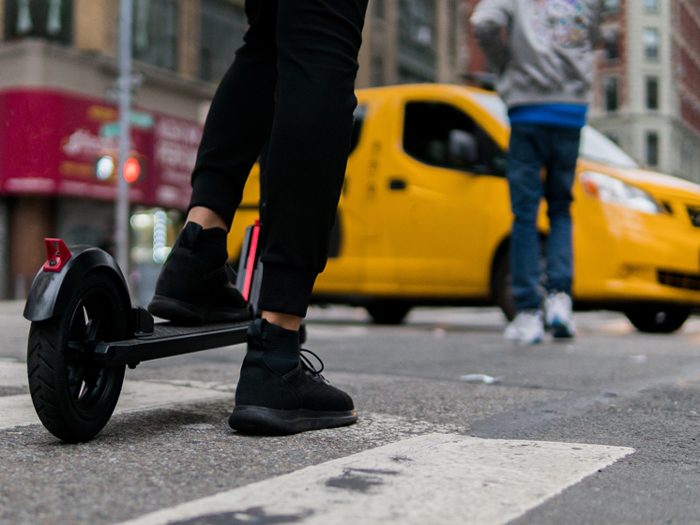Booming Scooter Service Challenges Risk Management Conventions

From a start of effectively zero in 2017, there were more than a million scooter rides in 2018, noted Jillian Slyfield, digital economy practice leader at Aon.
“That trajectory has not slowed. There was a turn a few months ago where more than half of new scooter rides are outside the U.S.”
Demographic, technological and cultural trends have combined to make urban mobility, or micro-mobility, one of the fastest growing new segments of the transport sector worldwide. That is driving emerging risks in the sense of new insureds using new technology in a new business segment.
The global bike rental market is expected to reach $4 billion by 2025, according to a February report by Hexa Research.
“Increasing penetration, easy access, attractive pricing, and support of local authorities are among the key driving factors driving the growth of bike rental services,” the report said. “Use of digital platforms by service providers is also expected to add to the growing adoption of rental services in the coming years.”
Powered scooters are newer and also more difficult to quantify. Some are really just powered bikes or mopeds. Some are small electric motorcycles.
The report also noted that the segment has attracted serious capital: “The global bike rental market has witnessed a substantial increase in venture capital investments. The majority of the players operating in the global market are raising funds through venture capital financing for expanding their business reach and deploying a larger fleet.”
Hexa differentiated two operational types: “In 2017, docked rental services dominated the market accounting for more than 75% of revenue share. However, dockless bike rental service is expected to grow at a higher compound annual rate of more than 19% in the coming years.
“The proliferation of internet of things (IoT), the global positioning system (GPS), and mobile app-based payment systems have eased locating, tracking, and payment activities, which is expected to add to the growing adoption of rental services.”
The global market is highly competitive, Hexa added. “Companies are focusing on expanding their geographic reach through mergers & acquisitions and are leveraging the venture capital route to finance their operations. Mobike, ofo, and Lyft are some of the key service providers,” the report said.
“Mergers and acquisitions have been a key strategy among potential participants. For instance, in June 2018, Lyft completed the acquisition of Motivate, the operator of Citi Bike in New York City for $250 million.”
The Rules of Liability Still Apply
As a point of departure for insurance and risk management, decades of civil and liability law still apply. If a car driver hits a bicycle or scooter rider, the driver is usually responsible. If the scooter rider hits a pedestrian, the rider is usually at fault. If a scooter rider falls into an open manhole, the utility or municipality is probably responsible. And if a scooter rider does not return his or her ride, that is theft.
Still it will take some litigation and clarification of existing laws and precedents. “Pedestrians who have been hit by scooter riders have sued the rider and also the scooter operating company,” said Slyfield.
More Like This: Hundreds of Scooter Riders Are Skittering Through the Streets. But Who Should Be Liable in the Case of a Crash?
She explained that the Graves Amendment (49 U.S. Code § 30106. Rented or leased motor vehicle safety and responsibility) could logically be extended to bike and scooter rental firms, but beyond some municipalities, that has not formally made de jure.
“Scooter companies are trying to exert the Graves veil,” said Slyfield, “but that is still up in the air. Cases are working their way through the courts. It looks like an existential question for the scooter companies. There are some local limits on liabilities, but questions extend to issues like environmental claims. If a scooter with a lithium-ion battery falls – or is thrown – into a body of water, who is responsible for environmental damages?”
While those granular details are ground out in the courts, Slyfield actually spends about 60% of her time on issues supporting mobility services more broadly. That includes ride-sharing technology.
“There are all of the inherent New Economy digital risks as well as the liability issues,” she said. “There are new risk profiles where businesses have changed.”
Slyfield works with a team of cross-functional brokers. “These are unique placement challenges. They are the ones who do it the first time through. We also do a lot of consulting for underwriters.”
Long Live the Scooter Revolution
However the liability issues are established, “micro-mobility is here to stay,” said Rob Bauer, U.S. sharing economy and mobility practice leader at Marsh. “In Uber’s S-1 filing it noted that self-powered or battery-powered rides of less than three miles are a threat to its profitability.”

Jillian Slyfield, managing director and U.S. sharing economy practice leader, Aon
Given that both major ride-sharing firms have been notorious for their lack of profitability, it is helpful to look at other ways of measuring the outlook for bike and scooter companies. “I’m excited about this summer,” said Bauer. “This is the first time that large numbers of people around the country have access to these services. This could be a defining moment. We are also starting to see business uses, such as delivery services. To this point, bike and scooter use has mostly been personal.”
A notable and instructive exception was in the 1980s, when reckless bike messengers were the terror of midtown Manhattan. Mostly they got themselves hurt, and a few even died in traffic, but a few pedestrians were also injured. The riders were mostly individuals, not businesses, and their lack of liability coverage led to strict regulations by the City Council.
But to Bauer’s point, the high utility and low cost of scooters make them ideal for local light delivery and other commercial uses. That in turn further complicates the liability issue. As has been noted, pedestrians hit by scooters have attempted to recover not just from the rider who hit them, but also the scooter company. If the rider was an independent contractor for a business, that liability will likely be tested in court as well.
“The rules of the road for bikes and scooters as a business are just being written now,” said Bauer. “The social norms as well. The new risks are by analogy. The plaintiff’s bar has argued that a scooter rider is more like a driver [in terms of liability] because the scooter is powered. There are some countries that regulate scooters as motor vehicles.”
The Risk Management Side of Scooters
While there is no question established norms of liability and responsibility will have to be adapted to the new business of micro-mobility, there are wholly new risk management matters as well.
“There are new uses of technology,” said Bauer. “There are mapping algorithms that allow a user with a cell phone to find the nearest station. That involves an exchange of data and location. There is also credit card data transmitted and perhaps stored. There have to be practices for how that is handled, and how that data travels.”
There is also the matter of two-way communication in multiple languages. Some of the greatest potential use for bikes and scooters is by tourists. What if an English credit card holder rents a scooter for herself and her American friend in Germany, or Thailand, and the friend has an accident?
“Certainly all the operators have user agreements,” said Bauer. “They do the best they can to disclaim liability by the provider and to put operational responsibility in the hands of the rider. From an insurance standpoint, we are looking at the core risks and also looking at indemnity. There are many new risk-management angles that need to be solved.”
Bauer reiterated that this summer will be a defining moment for scooters, even more so than bike services.
“We are in the very early stages for these services,” he said. “One of the great growth areas for micro-mobility is universities.”
They are ideal for many reasons, he explained. The demographic of users is spot on. Also the geographic size of a college campus is often the ideal range of five miles or less. Lastly the liability is simplified in many cases by eminent domain on the part of the institution. &










